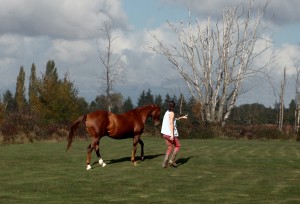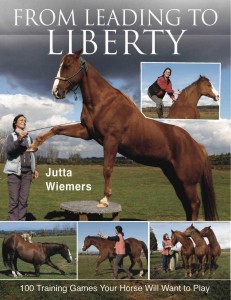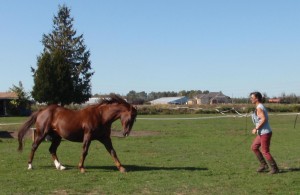What is liberty – Part 3
|
|
Was ist Freiheitsdressur – Teil 3
|
Necessary knowledge to motivate your horse:
- You will learn to understand the difference between your logic (based on the needs of a predator and cemented in your genes) and your horse’s thinking (based on his needs of a prey animal and as such automatically diametrically opposed to thoughts of a meat eater like you – this is also established in his genes and can’t be changed by you).
- Once you begin to realize how the flight animal ‘horse’ sees the world (from eyesight to digestion almost everything is different), the first step is taken.
|
|
Das nötige Wissen, um sein Pferd motivieren zu können:
- Wir müssen den Unterschied erkennen zwischen unserer Logik (entstanden aus den Bedürfnissen eines Raubtiers und in unseren Genen verankert) und der Denkweise unserer Pferde (begründet auf den Bedürfnissen eines Fluchttieres und damit automatisch den unseren als Fleischesser genau entgegengesetzt – was ebenfalls in seinen Genen verankert ist und von uns nicht geändert werden kann).
- Wenn man einmal erkennt, wie das Fluchttier Pferd die Welt sieht (von der Sehweise bis zur Verdauung ist ja vieles ganz anders), dann ist der erste Schritt zur Verständigung gemacht.
|
 Clear body language “this way!”
|
Learn to speak ‘horse’ by body language:
- Then you learn to speak ‘horse’ – and your predator body language will change and become calmer. Your ‘visible communication’ will start to make sense to your partner. As your horse constantly observes you, your movements must become ‘understandable’ to him, so he can figure out what you really want. He will stop to be so tentative and gain more self-assurance – then he can begin to experiment without being afraid of punishment – and become playful.
- Ten important ‘words’ of ‘body speak’ are enough to start out (see “From Leading to Liberty” Game 1) – and the wonderful thing is that any horse understands them! Punishment is never nice and also ineffective: Naturally we do not punish – play and voluntary interaction has nothing to do with obedience!
|
|
Pferdesprache ist Körpersprache:
- Nun lernen wir „pferdisch“ sprechen – und unsere Raubtier-Körpersprache muß sich ändern und weniger direkt und aggressiv werden. Unsere ‘sichtbare Kommunikation’ erscheint unserem Partner dann sinnvoll. Da Ihr Pferd Sie ständig beobachtet, müssen ihm Ihre Bewegungen verständlich werden, sonst kann es nicht erkennen, was Sie von ihm wollen. Es wird nicht mehr so vorsichtig herum probieren, sondern selbstbewußter werden – nun kann es anfangen spielerisch zu experimentieren ohne sich vor Strafe zu fürchten.
- Zehn wichtige ‘Vokabeln’ der Körpersprache sind anfangs schon genug – und das Schöne an der Sache ist, daß jedes Pferd sie verstehen wird! (Im Buch „From Leading to Liberty“ sind diese im Kapitel 1 illustriert!) Strafe ist nie angenehm und außerdem nicht effektiv: Wir strafen nicht – Spielen und freiwillige Mitarbeit hat mit Gehorsam nichts zu tun!
|
 Jutta’s latest book! |
The horse learns by association,
- in other words he learns that he has found the right solution (or at least the right path toward the solution) of your request by being instantly ‘positively re-inforced’ by you. Learning this technique, recognizing that the horse has indeed taken a step in the right direction, however tiny, and the speed with which you have to react, is part of your home work. If you do not reinforce an action within ½ second of its occurrence, the horse will not ‘associate’ and not understand what the reward was for – so no ‘learning’ takes place.
|
|
Das Pferd lernt durch Assoziation,
- das heißt, es begreift, daß es die richtige Lösung gefunden hat (oder zumindest eine auf dem Weg dahin), da Sie es sofort positiv bestärken. Das Erkennen, daß das Pferd tatsächlich einen Schritt in die richtige Richtung getan hat, und die Schnelligkeit, mit der man darauf reagieren muß, ist Teil unserer Hausaufgaben. Wenn man ein Verhalten nicht innerhalb einer ½ Sekunde bestärkt, kann das Pferd Verhalten und Verstärkung nicht ‘assoziieren’ und begreift nicht, wofür es die Belohnung bekommen hat – daher lernt es nichts dazu.
|
 Proud to stick around! Reinforce often! |
You must earn and deserve your ‘rank’ – respect comes at a price:
- You must become a trustworthy leader, if your horse is to feel safe with you. He takes his cue for flight or not spooking from you! Therefore you have to be high ranking and gain your horse’s respect – but a lead-mare does not boss the other herd members around (this under-standing of ‘alpha animal’ would be mistaken). She knows better (about important things in the horse world) and therefore makes the correct decisions.
- You will develop those leadership qualities – and then regularly be tested by your partner to ascertain that you are still up to snuff! Part of knowing your horses is to study and imitate their respect demanding behaviour, which ‘politely’ avoids conflict, as well as their signs of friendship – this goes far beyond sticking carrots into their front end!
-
to be continued: read on in Part 4 !
|
|
Seinen Rang muß man sich verdienen – Respekt hat seinen Preis:
- Damit sich Ihr Pferd mit Ihnen sicher fühlen kann, müssen Sie ein vertrauenswürdiger Anführer werden. Wenn Sie das werden, dann trifft es seine Entscheidung “fliehen oder nicht fliehen” nach Ihrem Verhalten! Schon daher wollen wir ranghoch sein – aber eine Leitstute ist nicht Anführer, um den Rest der Herde herum zu kommandieren (das wäre ein Mißverständnis der ‚Alpha-Rolle‘). Sie ist die Erfahrenste (in Dingen, die in der Pferdewelt wichtig sind) und trifft daher die besten Entscheidungen.
- Diese Führungsqualitäten muß man entwickeln – und dann wird man von seinen Partnern regelmäßig getestet, um sicher zu stellen, daß man noch auf Zack ist! Man kennt seine Pferde erst, wenn man ihr Verhalten studiert hat: Wir ahmen nach, wie sie untereinander Respekt verlangen und so in der Herde erreichen, daß Konflikte ‚höflich‘ vermieden werden können. Wir kopieren auch, wie sie Freundschaft ausdrücken – was ein bloßes Möhrenfüttern weit überschreitet und viel effektiver ist!
-
Fortsetzung folgt mit Teil 4 !
|
|
|
|
|
|
|
|
|




